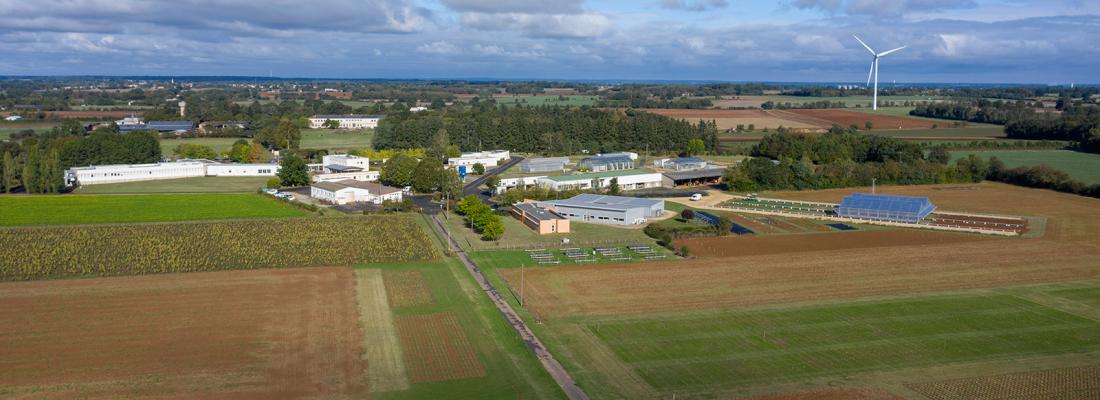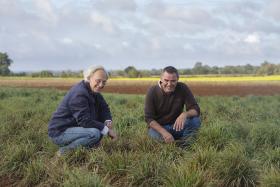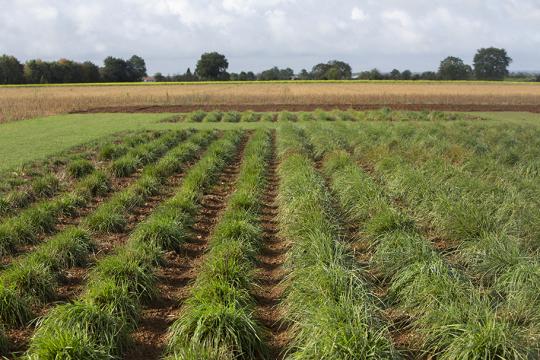Climate change and risks Reading time 12 min
Preparing grasslands to better adapt to climate change
Published on 06 December 2019

Introduction
In France as in Europe, grasslands are a key component of agricultural systems. They contribute to livestock farming, the economic performance of farms, and the quality of the environment. When it comes to climate change, grasslands are a valuable ally.
Climate change has an effect on three main sources of variations in grassland yields: precipitation, air temperature, and CO2 levels in the atmosphere. How will grasslands fare in a future marked by a lack of water, higher temperatures, and greater CO2 levels?
At INRAE, grasslands are at the heart of the work of the Multidisciplinary Research Unit for Grasslands and Forage Crops – URP3F - at the Institute’s Nouvelle-Aquitaine Poitiers centre. Researchers there focus on the functioning of sown grasslands and how they can better cope with the constraints of their environment. A facility that simulates extreme climatic conditions (Siclex) has recently allowed scientists to carry out experiments on land in Lusignan on the adaption of grasslands to climate change.
Far from the bucolic and somewhat outdated image that they sometimes evoke, grasslands are, scientifically-speaking, a perennial herbaceous plant community consisting essentially of grasses (or poaceae) and legumes. They are usually mowed for hay or silage, or used for grazing.
The first time I come across a grassland like the ones at home, with grass - real grass, damp and cool - I will kick off my shoes and walk through it barefoot (Albert t’Serstevens, 1933).
Grasslands go by several names around the world: steppe on the borders of Eurasia, pampas in South America, veld in South Africa, and alpine pastures in a mountain setting. Scientists and public authorities speak of permanent grasslands to refer to a given surface area covered with grass for more than five consecutive years. Short of that, they speak of temporary grasslands. Breeders make a distinction between natural and sown grasslands.
Grasslands: more than 40% of European farmland
In the 27-member state European Union, usable farm area, that is, arable land (major crops, market garden crops, etc.), areas that are always covered with grass (permanent grasslands, alpine pastures), and perennial crops (vines, orchards, etc.) account for some 173 million hectares (ha), i.e. 41% of total land. In France, usable farm area represents about 29 million ha, i.e. about half of the country’s surface area (54%).
In the 27-state European Union, permanent and temporary grasslands cover 64 million ha, i.e. 39% of total usable farm area. Permanent grasslands outweigh temporary grasslands, at 33% and 6% respectively.
However, the figures vary widely from country to country. Permanent grasslands make up more than half (76%) of usable farm area in Ireland, whereas in France the figure is 45%. In some countries in southern Europe, the figure is marginal (less than 10% in Greece). Temporary grasslands weigh in heavily in northern Europe, especially Sweden (33% of usable farm area), while in France the figure stands at a mere 9%. The share is particularly low (less than 3%) in many Eastern European member states.
Grasslands, a multi-functional ground cover
European grasslands provide many ecosystem services including:> Producing feed for ruminants
> Producing good-quality water
> Storing carbon
> Maintaining biodiversity
> Keeping soil erosion in check and promoting soil sustainability
> Contributing to the economic vitality of regions
Sources: Agreste, Eurostat, J.-L. Peyraud et al. Fourrages (2012), 211, 195. C. Huyghe et al. Actes du Colloque présentant les méthodes et résultats du projet Climagie (métaprogramme ACCAF), 2015, Poitiers (FR). 223 pages.
Three questions for Jean-Louis Durand, the research is in the field
Levers of the agroecological transition, grasslands make up 70% of the planet’s cultivable surface, accounting for no less than 13 million hectares in France. How will plants survive rising temperatures and other aspects of climate change over the next 10, 20 or 50 years? We speak to Jean-Louis Durand, director of the Multidisciplinary Research Unit for Grasslands and Forage Crops (URP3F).
Director of URP3F and head of the Grassland Observatory, Jean-Louis Durand tells us more about a facility that simulates extreme climatic conditions: Siclex. It is an innovative experimental tool which can currently modify rainfall and temperatures in controlled conditions.
How does Siclex help further research on grasslands and forage plants?
Siclex is a unique, technically very sophisticated facility that combines several tools and innovations to simulate extreme climatic conditions.
With Siclex, we can manipulate three parameters that are affected by climate change: precipitation, temperature, and, ultimately, CO2 levels, all of whose variations are likely to have repercussions on yields but also the environmental and social performance of grasslands. A mobile shelter intercepts rain above plots of land to simulate drought, an irrigation system supplies water to plants, and a heating device creates conditions of extreme temperatures of variable and controlled intensity. Soon, a device to increase levels of CO2 in the air will be added, as well as humidity and air and soil temperature sensors and automated measures to evaluate how these climatic conditions impact the growth of plants. All this will be conducted over a period of several years.
Siclex allows researchers to closely and accurately monitor the quantity of water that flows into a grassland without disturbing plants’ needs for water and sunlight. The time it takes to work, especially for the mobile shelter to move around, is short, in order to avoid side effects liable to disturb plants’ water uptake.
What role does Siclex play in research on grasslands and climate change?
Siclex is first and foremost a knowledge-based tool. It forecasts how grasslands change and helps scientists make recommendations accordingly.
Currently, we know about the individual phenomena linked to drought, rising temperatures and increased carbon dioxide levels in the air, thanks to computer codes that combine these functions. But we don’t know how a given grassland evolves under certain conditions, including those forecast by climate experts from the IPCC which we will likely have to deal with in 30 years’ time. We need this knowledge to be able to work out the criteria for varietal selection and grassland management, especially since the control loops are complex. Take, for instance, increased levels of CO2 in the atmosphere which stimulate photosynthesis boosting the productivity of plants which, if left to their own devices, will grow very quickly. This is turn reduces evapotranspiration, shifting the impact of drought by causing stomata to close… The problem is, it is these same stomata that absorb CO2 in the air. The interaction between soil bacteria and legumes is also affected. Thanks to the former, the latter are able to absorb nitrogen from the air and feed on it, and they benefit from increased CO2 levels in the air without being limited by the nitrogen supply. Increased CO2 levels are also liable to modify the balance between different plant species or between plants and the soil.
Are we able, today, to predict the short-term changes of grasslands made up of 30% legumes and 60% grasses with a water deficit of 50%, a 2°C increase in temperatures, or carbon dioxide levels of 500 ppm? This is not something we can randomly predict, so it quickly became apparent that we needed accurate models.
Siclex also allows us to validate models despite complicated or contrasting conditions. These models, called individual-centred, are extremely detailed, down to the last blade of grass, simulating leaf surface, position of leaves in space, photosynthesis and water needs. Our simulation team has recently grown; it now consists of five researchers and has built strong ties with many INRAE teams from Dijon Bourgogne-Franche Comté, Île de France Versailles-Grignon and Occitanie Montpellier.
Lastly, Siclex lets us evaluate species and varietal mixtures created for experimental purposes. This mixture objective is very much a part of the simulation objective.
What are the prospects for Siclex ?
Siclex is still in an experimental phase. From a technical point of view, there is a lot of room for improvement, and improve it will. The ongoing trial, launched in March 2018, with first results in October 2019, will continue. This year brought a sublethal water deficit and we are keeping a close eye on how the plants cope. Next year will bring a greater, and therefore lethal, water deficit.
Siclex is already branching out to the wider world: on a national level with the Association of Fodder Variety’s Creators (ACVF), and at the European level with research projects like the one dedicated to genetic resources of legume plants - EUCLEG (EU 2017-2021), coordinated by URP3F. As such, Siclex is also a great choice for analysing plant genetic resources: it lets scientists impose on plants, in a short time and limited space, climatic conditions that would normally require several separate trials and longer observation periods.
Siclex, a first for everything
2014 An idea first takes shape
2017 First stone laid
2018 First test carried out
2019 First results
Weight, shelter and rails 13.6 t
Usable surface covered 550 m²
Speed of travel 12 m/min
Wind resistance 140 km/h
> Identify traits of ecological and agricultural interest in fodder species populations
> Select elite individuals in populations with a view to improving populations
> Test populations for specific and well-described drought conditions
> Validate models of grassland evolution for various specific and varietal compositions
> Create mixtures based on perennial fodder varieties that save on water and nitrogen.
Siclex, a modern tool at the service of varietal selection

At INRAE, studying fodder production in a context of climate change just got easier thanks to an experimental facility designed to do just that: Siclex. This research programme to evaluate the response of innovative genetic material to water deficit in fodder species is the first experiment carried out with the new technology.
Whether permanent or temporary, grasslands inevitably go through periods of drought at some point over the course of their life, especially in summer. The plants that make up the grasslands are sensitive to this lack of water. If the level of drought is moderate, plant life generally returns to normal levels when the autumn rains return. However, this recovery will be more and more uncertain in light of climate change, threatening the autonomy of grass-based forage systems.
Studying how different forage species and varieties react to water scarcity with a view to improving them is a challenge when it comes to conducting experiments. Because improvement involves alternating the production stages of new plant material created by cross-breeding with evaluation phases to assess performance, with a view to selecting the most promising offspring and/or parents. In the field, it is impossible to compensate for the random nature of precipitation without conducting multiple trials in different places at great expense.
Thanks to the experimental facility Siclex, scientists have been running experiments since 2018 specifically designed to study plant genetics and breeding, in order to help them better adapt to climate change. With Siclex, precipitation can be controlled, in terms of intensity as well as choosing a precise time of year, all without disturbing the exposure to sunlight plants get in the field.
In the spotlight
Within the framework of projects carried out by Marc Ghesquière, researcher at INRAE and co-head of the Grassland Observatory and Thierry Bourgoin, an engineer from Agri-Obtentions, two genetic models of forage grass are currently being studied with Siclex:
- Dactylis glomerata, in the genus Dactylis, a grass species of great interest for forage purposes, thanks to its excellent capacity to adapt to a very wide range of pedoclimatic conditions.
- Drawing on a long history of breeding experiments with this species, URP3F, in tandem with the subsidiary INRAE Agri-Obtentions, has recently broadened the scope of its approach to plant tolerance to severe drought in summer by creating hybrids between cultivated varieties that are well adapted to oceanic climates and Mediterranean populations.
- Festulolium, a hybrid between a species of Festuca, Ferocactus glaucescens, from which it gets its capacity to extract water from deep within the soil with its root system, and a species of ryegrass, Lolium multiflorum Lam., which grows quickly but is sensitive to drought and not very perennial.

While plots of land were being observed under Siclex, the same Festulolium genotypes were duplicated by transplanting 30 plants per genotype in an isolated nursery. Their growth rate and early ear emergence in springtime were observed, and the characteristics of individual plants compared with the response to drought of the same genotype in plot conditions.
A trial was sown in August 2018 representing 154 plots of 1.5m² each. Dactylis and Festulolium each accounted for about half of the plots, with 51 and 47 genotypes respectively. From May to August 2019, it suffered a water deficit consisting of total withdrawal of all precipitation. In September 2019, the plots were harvested for the first time after complete re-irrigation of the trial with 60 mm of water.
Keeping a close eye on trials
Photographs of the plots are taken regularly by drones (which also provide geolocation data), giving scientists access to the plants’ growth kinetics, for example at the start of water deficits, the onset of senescence, and when growth resumes after the re-irrigation stage of the trial. This allows for a quantitative analysis of the potential mortality/degradation rate and helps scientists identify those genotypes that make a complete come-back, or recover more or less quickly, revealing a tolerance to drought that makes them viable candidates for selection.
At harvest time, the quantity of biomass is evaluated. The samples collected are then analysed to determine their protein content and digestibility by ruminants.
While plots are under observation, a genomic evaluation of the two species of grasses allows scientists to compare and contrast the characteristics observed with phenotypic variability.
A clean cut
On Wednesday, 2 October 2019, the autumn sun burned bright and Siclex was in all its glory. The time had come to harvest the plots planted a little over a year. This was a first, and there to witness it, alongside Marc Ghesquière and Thierry Bourgoin, were many INRAE colleagues including Rodrigue Véron at the harvester and Mallaury Delincourt at the scales.
A few hours later, emotions were running high when the two trials were harvested.
The next steps involve more observations with a view, ideally, to selecting plants and developing a new process either of cloning, for conservation purposes, or crossbreeding to produce a new generation of seeds.
